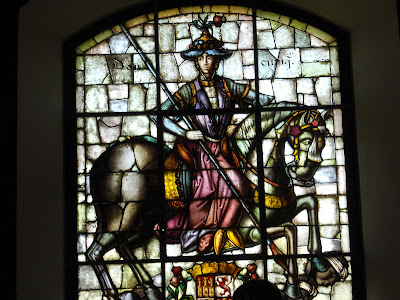Segovia is considered a World Heritage Site, having the Segovia Aqueduct, Alcazar of Segovia, and Segovia Cathedral to list a few.
The first thing to see in Segovia is the Aqueduct. Designed by Marcus Vitruvius Pollio, the aqueduct was built in the 1st century AD without mortar--unbelievable. It was then rebuilt in the 15th century due to partial destruction by the Moors. It has 166 arches built of granite blocks--consisting of single and double arches divided into 2 levels. The top section is where the water actually flows through. The water comes from the Fuente Fria River in the mountains about 17 km (11 miles) away.
After seeing the aqueduct, we toured around the city, observing the architecture and design of the buildings. Segovia is known for the texture on buildings called "Esgrafiado" (pictured below). Esgrafiado is "Sgraffito" in English and is a form of wall decor (note it sounds like graffiti).
We then saw the Segovia Cathedral, a Roman Catholic cathedral dedicated to the Virgin Mary. It was built between 1525-1577 in a later Gothic style, consisting of many pointed arches (Arcos Apuntados) and pinnacles (pin aculos). The outside is beautiful, however we did not go inside (which I wished we would have).
 |
| Segovia Cathedral (a bit fuzzy, sorry!) |
 |
| Lindsay in front of the Segovia Cathedral (notice the gothic-style pinnacles) |
Alcazar of Segovia (meaning Castle of Segovia) was my favorite of all the attractions. The inside consisted of many intricately designed rooms with embellished ceilings, stonework, crests, and artwork. It was originally built as a fortress for the Arabs, but it then served as a Royal Palace for King Alfonso VIII and his wife, Eleanor of Plantagenet. After that, many other royals lived there such as King Ferdinand III, King Alfonso X, King Juan II and King Enrique IV, to list a few. Aside from it being a royal palace and Artillery College, it was also an inspiration for Walt Disney's Cinderella Castle (which I have no doubts as to why).
After seeing the Alcazar of Segovia, we went to tour La Iglesia de Vera Cruz (Church of Veracruz--meaning Church of the True Cross). This was the Church of the Knights Templar, a medieval secret society. The structure is twelve-sided with one tower on the south end. At one point it was thought to have a fragment of the true cross, thus the name.
As you can imagine, all of this is a lot of walking with a ton of stairs (some of which were not very level, which of course invited some graceful tripping...). So, we took a break and had another delicious multi-course luncheon at El Rancho de la Aldegüela. The menu included:
Tortilla de patata*
Pimientos rojos asados*
Croquetas caseras*
Pan tomaca*
*in tapas form*
Pollo asado con ensalada mixta
Ponche de Segovia
Agua y Cafe
- Spanish Tortillas de Patatas are very different than tortillas in the States. They are essentially an omelette (eggs and potatoes + extra ingredients to make a pancake like form).
- Asado means "roasted". So the red bell peppers (pimientos rojos) and the chicken (pollo) were roasted to perfection and were so delicious.
 |
| The array of tapas-style appetizers--notice the Spanish "tortilla" in the lower left hand corner. Also, in Spanish restaurants (and I believe throughout Europe) they serve water in bottles. |
 |
| Ponche de Segovia--a marzipan-custard layer cake that has powdered sugar and caramelized sugar lattice on top, a must-try in Segovia. |















No comments:
Post a Comment